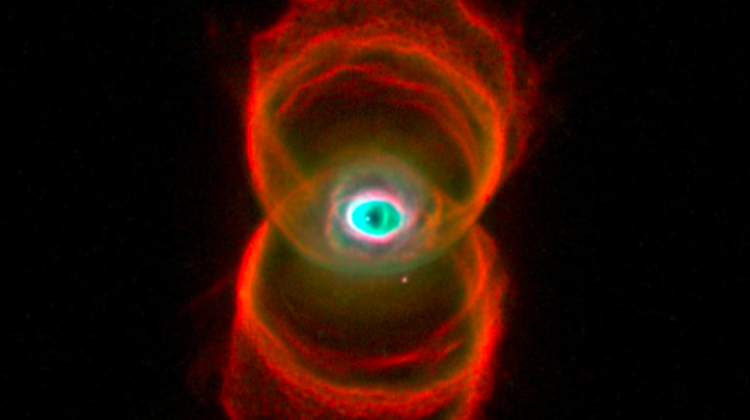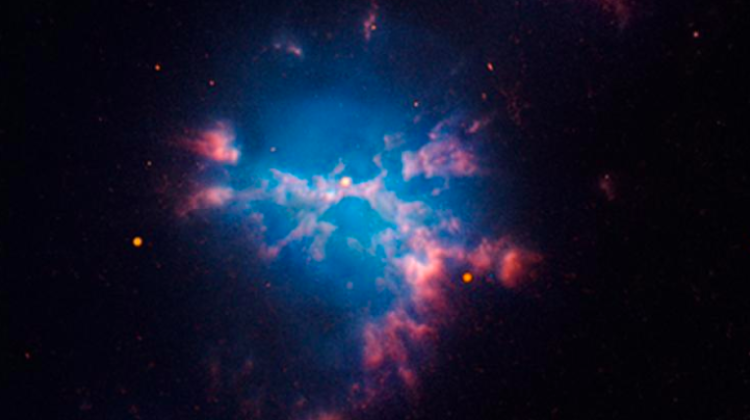We now know what`s in the centre of the famous Engraved Hourglass Nebula
 The Engraved Hourglass Nebula; Credit: Raghvendra Sahai and John Trauger (JPL), WFPC2 science team, NASA/ESA
The Engraved Hourglass Nebula; Credit: Raghvendra Sahai and John Trauger (JPL), WFPC2 science team, NASA/ESA
There is a binary star system in the centre of the extremely photogenic Engraved Hourglass Nebula - two stars that revolve around each other once every 18 days - showed astronomers, including Polish researchers. The research was conducted on SALT - one of the world`s largest optical telescopes.
The Engraved Hourglass Nebula (MyCn18) is an exceptionally spectacular object in the sky. Its image taken two decades by the Hubble Telescope was a sensation. It not only made the cover of "National Geographic", but also one of the Pearl Jam albums. The image shows two overlapping red circular shapes, and in the centre between them shines an amazing, blue-green "eye".
Astronomers wondered where this unusual shape came from. Research by an international team led by Brent Miszalski (SAAO) sheds light on how this nebula could have formed: in the centre of the Engraved Hourglass Nebula, researchers discovered a binary star system with a period of 18.15 days.
"A binary star system is two stars that revolve around each other, or more precisely - around a common centre of mass" - explains a research project participant, Prof. Joanna Mikołajewska from the Nicolaus Copernicus Astronomical Center of the Polish Academy of Sciences in Warsaw. The research shows that the masses of stars are 0.6 and 0.19 solar masses.
Scientists expected to find a binary system in the centre of the nebula, but one with completely different properties. "The nebula has various peculiarities. There were attempts to explain them by the existence of a binary system with quite a long period of a few hundred, maybe a thousand days" - she says. It was a big surprise that the orbital period was much, much shorter - only about 18 days.
Prof. Mikołajewska points out that in an ordinary image you can not see that there are two stars in the centre of the nebula. "These stars are relatively close to each other, and our distance from them is large. We can not separate them in the image. We can only tell that this a binary system based on speed changes, in other words by observing the movement of the star" - she says.
She clarifies that the researchers measured radial velocities in this study. She compares it to the work of policemen who use a radar to measure the speed of passing cars. Prof. Mikołajewska explains: "We measure the speed in the spectrum of the star. We analyse the Doppler effect".
The research was carried out on the SALT (South African Large Telescope) telescope in South Africa, operated by an international consortium, in which Poland participates. It is currently the largest optical telescope in the world - its main mirror, consisting of 91 hexagonal parts, has a diameter of 11 meters. The telescope was directed at the Hourglass Nebula and 26 measurements were made at intervals. On this basis, researchers were able to determine whether the objects in the nebula were moving towards or away from the Earth and whether their velocity in relation to us was changing. This allowed to determine that there were indeed two stars in the centre of the nebula.
The team`s research is part of an extensive program of search for binary systems in nebulae. The work of scientists will allow to improve models related to the functioning of binary systems and the formation of planetary nebulae with non-spherical shapes.
Planetary nebulae can form at the end of life of medium-sized stars. The star ejects its outer layers and loses as much as 50-80 percent of its mass. Only the super-hot core remains in the centre. It emits only UV rays invisible to the naked eye. When this radiation reaches the scattered shell, it ionises the gas, and the nebula - a gigantic cloud around the star - begins to glow with visible light. It is known that the red colour comes from ionised nitrogen, green - from hydrogen, and blue - from oxygen.
The Engraved Hourglass Nebula is located in the constellation Musca, and its distance from the Earth is about 8,000 light years.
PAP - Science in Poland, Ludwika Tomala
lt/ ekr/ kap/
tr. RL
Przed dodaniem komentarza prosimy o zapoznanie z Regulaminem forum serwisu Nauka w Polsce.















